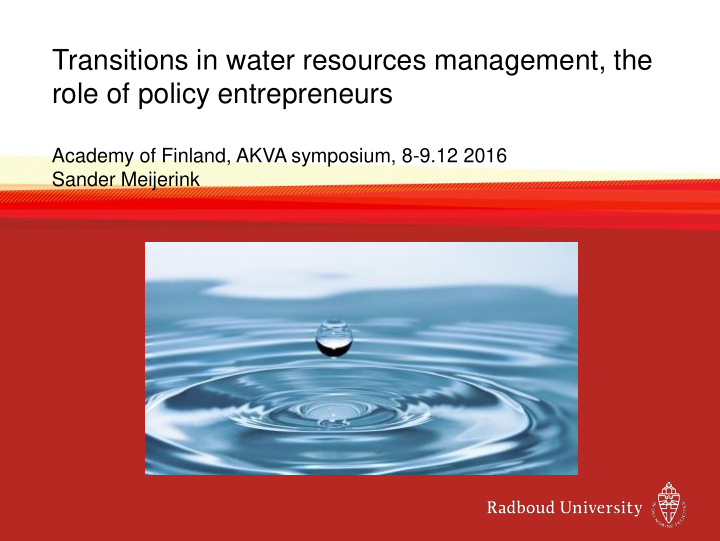



Transitions in water resources management, the role of policy entrepreneurs Academy of Finland, AKVA symposium, 8-9.12 2016 Sander Meijerink
Transitions in water resources management “ Major changes in water policies and practices ” Examples: ‘ Spatialization ’ of the water safety domain Ecosystem based water management Privatization of the water sector Participatory irrigation management Establishment of river basin organizations
Transitions and the role of policy entrepreneurs Role of key individuals/ ‘ leaders ’ / ‘ champions ’ in realizing change
Research questions • Which transitions have taken place in water management in the last decades in fifteen countries and the EU? • Were these transitions influenced by policy entrepreneurs? If so, which strategies did they employ? • What are the implications of these findings for those who aim to direct change?
Research strategy: qualitative case studies • ‘ Thick ’ descriptions of policy continuity and change • Cases cover two to four decades • Secondary analysis • Interviews with key individuals • Some very experienced researchers • Sub-case studies on regional or local level
Global discourses as ‘ policy viruses ’ (Richardson) • Ecosystem based water management (Germany, Hungary, Netherlands, China, Australia, Spain) • Participatory governance (India, Indonesia, Tanzania, EU…) • Decentralization (Turkey, Mexico, Indonesia) • Privatization, marketization (Turkey, Tanzania, Mexico, EU)
Observations • Many similarities in direction of change • New policy ideas do not replace the ‘ old ’ ones (layering or ‘ sedimentation ’ of new ideas and practices) • Those who have an interest in maintaining the status quo delay policy implementation (policy change is a ‘ two-level game ’ )
Were policy entrepreneurs involved? • Yes, it is possible to pinpoint key individuals who influenced the direction of policy change in most cases • Policy entrepreneurs in many positions: NGOs, politics, local and national bureaucracy, scientists • Commonalities: (1) Good reputation within communities, (2) Networking skills, (3) Perseverance
Collective entrepreneurship • Relatively small groups of individuals • Who play complementary roles • Different capabilities
Strategy: securing support/coalition building • Advocacy: selling you ideas • Brokerage: striking deals with those who have different ideas
Strategy: exploiting problem windows • Successful entrepreneurs exploit problem windows: crises (floods, drought, but also financial crises) • ‘ Never waste a good crisis ’ • Framing contests
Strategy: anticipating windows • Successful policy entrepreneurs anticipate windows of opportunity by developing and testing attractive policy alternatives and demonstrating their feasibility • Initiating pilot projects and experiments to demonstrate feasibility of new approaches (f.e. flood plain restoration China, Germany, Hungary, The Netherlands)
Strategy: exploiting political windows • Regime change (South-Africa, Indonesia, Mexico) • Change of an elected government or single minister (almost all cases) • Relevance of traditional party politics, f.e. Spain
Strategy: venue exploitation • Multiple venues (EU, nation state, regions, municipalities, court, professional for a, scientific conferences, and so on) • Venue manipulation (e.g. Indonesia, China, Netherlands) • Venue shopping (e.g. Spain) • Creation of new venues to be able to insert new ideas into decision making processes
Limits to imposing change • In the developing world donor organizations play a crucial role in changing national water policies • India, Indonesia, Thailand, Tanzania, Mexico, Turkey … • The top down strategy of imposing new modes of governance (f.e. introduction of water user associations) has largely failed
Lessons learnt • Policy entrepreneurship seems crucial to realizing water policy change • They use a broad range of strategies (coalition building, framing, window exploitation, piloting, venue shopping, and so on) • Different change dynamics in high and low-income countries
Recommend
More recommend